Memories of Circlorama |
Read more
at in70mm.com The 70mm Newsletter |
| Written by: James Robertson | Date: July 19, 2004 |
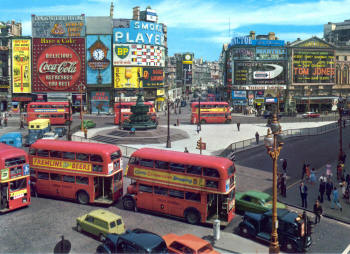 The
Circlorama Theatre is at the far left in the picture. See the yellow
poster.
Contemporary postcard. Editors collection.
Press
picture to see
enlargement The
Circlorama Theatre is at the far left in the picture. See the yellow
poster.
Contemporary postcard. Editors collection.
Press
picture to see
enlargementCirclorama ran in London for about 18 months in 1963-1964. I was a Shift Leader for the entire run so am able to give an idea of the daily operations. For those who have never heard of the system it comprised 11 projectors arranged in a circle pointing inwards to create a full 360º image on the 11 screens. The audience stood in the middle and spun around as the fancy took them. The effect was excellent and with a state of the art sound system provided an enjoyable entertainment. The projectors were Philips FP 20’s with the SSP 800 pulsed lamp system. |
Further
in 70mm reading: The true history of Circlorama 1962-65 More on Circlorama CircleVision 360 Kinopanorama Internet link: |
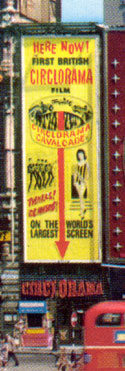 Enlargement
of the poster and entrance.
Contemporary postcard. Editors collection. Enlargement
of the poster and entrance.
Contemporary postcard. Editors collection.We originally had two shifts of 4 projectionist on each shift (soon reduced to 3–bean counters are not a new invention!) and a Chief Projectionist who floated and was of course responsible for the overall technical standards and the administrative baloney. The 2 shifts alternated day on day off starting at 09:30 and finishing at 22:30 (a long day but you always had the next day to recover. Being in England the first priority at start of shift was a CUP OF TEA which took us through to 1000 when we would do our routine maintenance which involved more cleaning of the lamphouse systems than the projectors (London water is very limey and we got a lot of scale build up in the cooling systems. The projectors just needed routine cleaning and oiling as required. In 12 months of 35mm operations we didn’t have a single projector failure. Most problems were with the pulsed lamps system and their Pulsator power units. The life of each lamp was only guaranteed for 33 hrs. and although many went beyond that, careful monitoring was necessary to watch for light output dimming, so that a new lamp could be inserted between shows. Lamps occasionally failed prematurely and although a back up would drop into place it took about 1-2 seconds to drop and stabilise. (Philips claimed the blackout was imperceptible - it wasn’t) The Pulsator power units which drove the lamps were sometimes a bit reluctant to start up and a judicious “technical tap” was occasionally applied to get them going. The light output from the lamps was just o.k. for the screen size(s) but was lacking in the red end of the spectrum so the images were a bit on the blue side. |
|
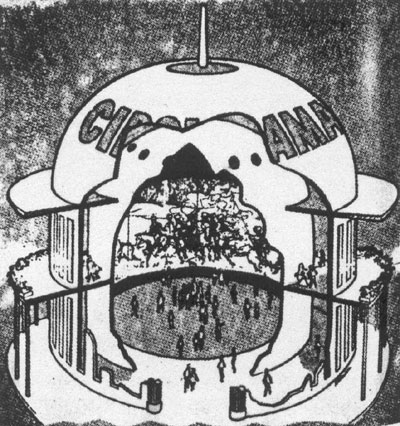 Drawing
of the cinema. Drawing
of the cinema.We did 20 shows of 20 minute s each day. This was long before platters and automation! The projectors had 6000ft magazines which allowed 3 shows on each reel. We would stop in interlock after show 1 get a new audience in and fire up again for show 2 then repeat process for show 3. At the end of show 3 new prints would be laced up and the process would start again. The six prints were run for a year and were still in good nick when the change over to 16mm was made (explanation later) Incidentally we’re talking 6000 ft. reels here. Every hour each projectionist had to re-wind 4 X 6000 ft. reels by hand. There was only one motor re-wind at Shift Leader’s station and naturally I had to be careful not to burn the motor out so had to keep it for my exclusive use. |
Format: 11 x 4-35 360° |
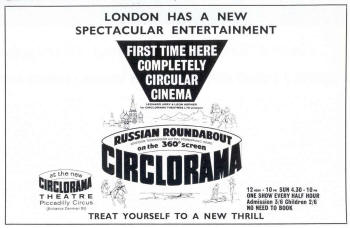 Press
picture to see
enlargement Press
picture to see
enlargementThe interlock system is worth a mention. After the 11 projectors and 1 sound reproducer were laced up on Start the interlock generator was engaged and the machines were all inched down in lock to “8 in the gate.” This allowed checking to see that everything was hunky dory and all machines were in sync. and in frame. The "Go" button was then pushed and the interlock generator brought everything up to speed and then automatically switched over to a.c. synchronous motors on the projectors which then locked to mains frequency. One oddity was the sound reproducer take-up. Whilst the projectors all had torque motors the reproducer had a conventional friction clutch which meant it was difficult to set as it had to be able to take up smoothly from 0 ft (show 1) 2000 ft (show 2) and 4000 ft. (show 3). That’s a big ask starting up with a 4000ft load. We basically had to set it so that it could handle the 4000 ft. take-up which meant it was a bit fierce on 0 ft. start! |
|
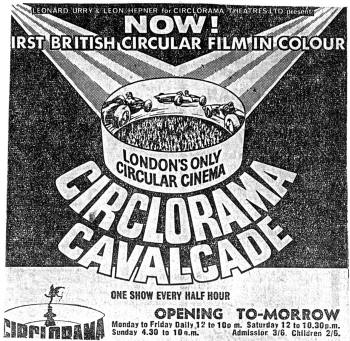 Press
picture to see enlargement Press
picture to see enlargementThe 35mm. version ran for about a year then we were due to get a new Russian film which was shot using a VERTICAL anamorphic system (no kidding). Anyway this fell through (I believe due to technical problems - surprise!) So we now needed a replacement to bolster falling attendances. An English travelogue was then shot using a 16mm camera system. All of our lovely 35mm gear was removed and replaced with Philips FP16’s. We ran the 16mm version for about 6 months. Of course this was much more difficult than running 35mm as the projectors and the film had still to do 20 shows a day. A couple of intermittents had to be replaced but the major problem was wear and tear on the prints. 6 new prints were required after 4-5 months and this plus maintenance costs and falling attendances finally force the company into bankruptcy. They still owe me my last months salary! I was so disillusioned I ran away to sea! I joined P&O as a ship’s projectionist but that’s another story! |
|
|
Go: back
- top - back issues
- news index Updated 22-01-25 |
|
